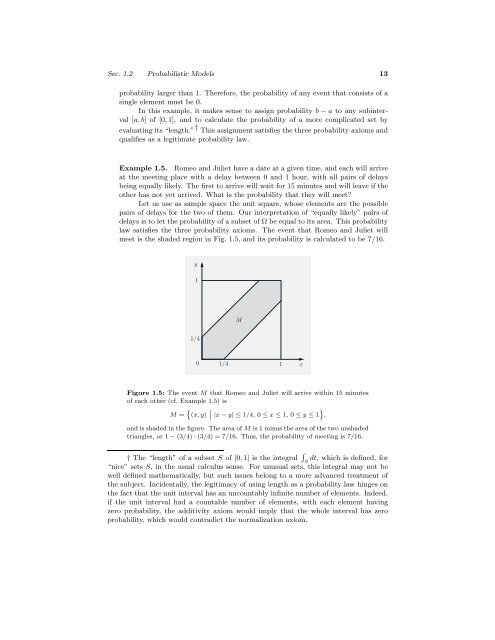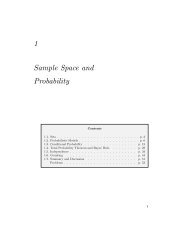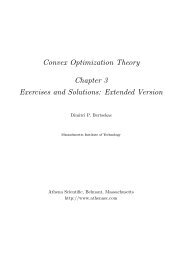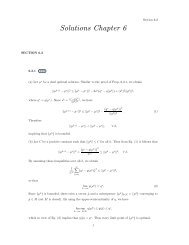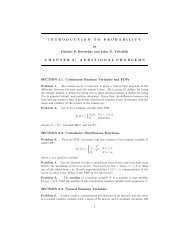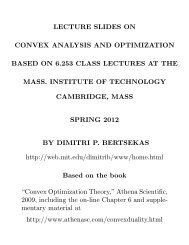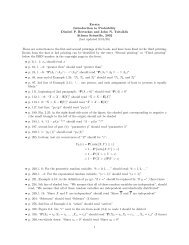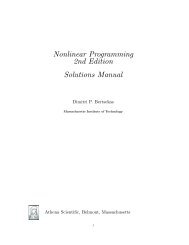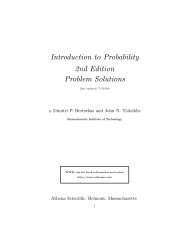Introduction to Probability, by Dimitri P ... - satrajit mukherjee
Introduction to Probability, by Dimitri P ... - satrajit mukherjee
Introduction to Probability, by Dimitri P ... - satrajit mukherjee
Create successful ePaper yourself
Turn your PDF publications into a flip-book with our unique Google optimized e-Paper software.
Sec. 1.2 Probabilistic Models 13<br />
probability larger than 1. Therefore, the probability of any event that consists of a<br />
single element must be 0.<br />
In this example, it makes sense <strong>to</strong> assign probability b − a <strong>to</strong> any subinterval<br />
[a, b] of[0, 1], and <strong>to</strong> calculate the probability of a more complicated set <strong>by</strong><br />
evaluating its “length.” † This assignment satisfies the three probability axioms and<br />
qualifies as a legitimate probability law.<br />
Example 1.5. Romeo and Juliet have a date at a given time, and each will arrive<br />
at the meeting place with a delay between 0 and 1 hour, with all pairs of delays<br />
being equally likely. The first <strong>to</strong> arrive will wait for 15 minutes and will leave if the<br />
other has not yet arrived. What is the probability that they will meet<br />
Let us use as sample space the unit square, whose elements are the possible<br />
pairs of delays for the two of them. Our interpretation of “equally likely” pairs of<br />
delays is <strong>to</strong> let the probability of a subset of Ω be equal <strong>to</strong> its area. This probability<br />
law satisfies the three probability axioms. The event that Romeo and Juliet will<br />
meet is the shaded region in Fig. 1.5, and its probability is calculated <strong>to</strong> be 7/16.<br />
y<br />
1<br />
M<br />
1/4<br />
0 1/4 1 x<br />
Figure 1.5: The event M that Romeo and Juliet will arrive within 15 minutes<br />
of each other (cf. Example { 1.5) is<br />
}<br />
M = (x, y) ∣ |x − y| ≤1/4, 0 ≤ x ≤ 1, 0 ≤ y ≤ 1 ,<br />
and is shaded in the figure. The area of M is 1 minus the area of the two unshaded<br />
triangles, or 1 − (3/4) · (3/4) =7/16. Thus, the probability of meeting is 7/16.<br />
† The “length” of a subset S of [0, 1] is the integral ∫ S<br />
dt, which is defined, for<br />
“nice” sets S, inthe usual calculus sense. For unusual sets, this integral may not be<br />
well defined mathematically, but such issues belong <strong>to</strong> a more advanced treatment of<br />
the subject. Incidentally, the legitimacy of using length as a probability law hinges on<br />
the fact that the unit interval has an uncountably infinite number of elements. Indeed,<br />
if the unit interval had a countable number of elements, with each element having<br />
zero probability, the additivity axiom would imply that the whole interval has zero<br />
probability, which would contradict the normalization axiom.


